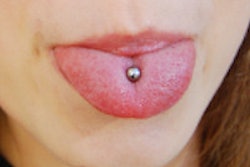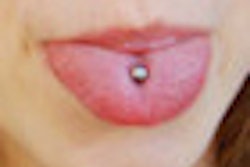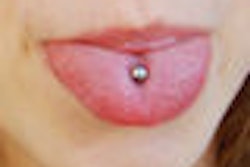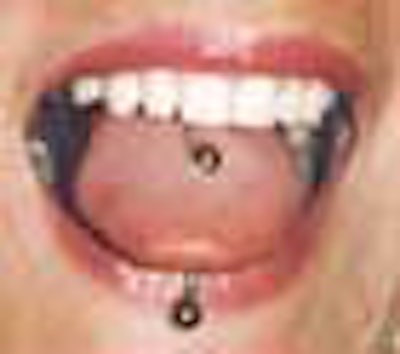
New evidence lends further support to the need for dentists to caution patients about the dangers of tongue piercing, which can lead to severe infections, chipped and fractured teeth, gingival recession, and even death.
The most recent fatality occurred in April of this year when a U.K. woman died of blood poisoning and pneumonia just 48 hours after having a steel bar put through her tongue. Last year, a young Israeli man developed multiple abscesses in his brain after getting his tongue pierced. He died two months later from severe septic shock and organ failure. And in 2007, a young Boston woman succumbed to viral meningitis in 2007 about a month after she got an infection from a tongue piercing.
The ADA's position is clear:
Oral piercings, which involve the tongue (the most common site), lips, cheeks, uvula, or a combination of sites, have been implicated in a number of adverse oral and systemic conditions. ... Because of its potential for numerous negative sequelae, the American Dental Association opposes the practice of intraoral/perioral piercing and tongue splitting.
Now two recent studies point to additional risks. The University of Buffalo (UB) has done studies regarding the deleterious effects of tongue piercing, including one which found that high school students who had barbell implants or studs produced a damaging habit of pushing the metal stud up against and between their upper incisors.
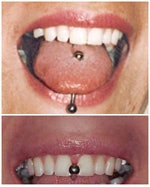 Tongue piercings. Subjects frequently develop a habit of pushing the metal stud in their tongues up against and between the front teeth, creating a gap. Images courtesy of the University of Buffalo.
Tongue piercings. Subjects frequently develop a habit of pushing the metal stud in their tongues up against and between the front teeth, creating a gap. Images courtesy of the University of Buffalo.
Repeated "playing" with the stud eventually caused a gap in the upper front teeth in many of the students, according to UB researcher Sawsan Tabbaa, D.D.S., M.S., an assistant professor of orthodontics at the UB School of Dental Medicine. And a more recent case study further illustrated this phenomenon (Journal of Clinical Orthodontics, July 2010, Vol. 44:7, pp. 426-428).
The study involved a 26-year-old woman examined at UB's orthodontic clinic who complained that a large space had developed between her upper central incisors. The patient also had a tongue piercing that held a barbell-shaped tongue stud. The tongue was pierced seven years earlier, and every day for seven years she had pushed the stud between her upper front teeth, creating the space between them and, subsequently, habitually placing it in the space. The patient did not have a space between her upper front teeth prior to the tongue piercing.
"It is a basic tenet of orthodontics that force, over time, moves teeth," Dr. Tabbaa said. The patient's treatment involved a fixed braces appliance to push the front teeth back together.
Gingival recession
Another new study evaluated the periodontal risk factors for gingival recession in individuals with tongue piercings (Journal of Clinical Periodontology [JCP], August 2010, Vol. 37:8, pp. 712-718). Researchers from the Federal University of Minas Gerais in Brazil found the practice is strongly associated with gingival recession, particularly in the anterior lingual mandibular region.
Gingival recession is of particular interest, the researchers noted, because it can increase susceptibility to hypersensitive dentine and root caries, especially as regards negative aesthetic effects (American Journal of Orthodontics and Dentofacial Orthopedics, November 2008, Vol. 134:5, pp. 652-656).
“It is a basic tenet of orthodontics that force, over time, moves teeth.”
— Sawsan Tabbaa, D.D.S., M.S.,
University of Buffalo
The JCP study included 60 students in the case group (those with tongue piercings) and 120 in the control group (those without piercings). Participants were both male and female and between 13 and 28 years of age. The study was conducted from January 2008 to March 2009.
Clinical evaluation of patient oral health records included periodontal parameters and the presence of tooth fracture. Periodontal exams were performed at six sites around each tooth: mesial, mesiobuccal, mesiolingual, distal, distobuccal, and distolingual (not including third molars).
The presence of inflammation and tissue destruction of tooth supports was assessed and the following elements recorded: probing depth (PD), clinical attachment level (CAL), plaque index, bleeding on probing (BOP), gingival recession, and the presence of tooth fracture.
The researchers found that the overall mean values of BOP, PD, and CAL, as well as those values within the anterior region, were higher in controls and differed significantly from cases (p < 0.050). In addition, the mean global gingival recession was higher in cases than in controls (p < 0.001), and the average gingival recession in the anterior lingual mandibular region was significantly higher (0.194 ± 0.288 mm) in cases than in controls (0.011 ± 0.036 mm; p < 0.001).
Most of the cases presented a mean time of use of two years. The habit of rattling the piercing was reported by 75% of users, while the occurrence of tooth fracture after insertion of the piercing occurred in 20% of users. Fracture of the anterior teeth was significantly more frequent in cases (26.7%) than in controls (11.7%, p = 0.011), as was the average number of fractured teeth (p = 0.046).
"Individuals with tongue piercings showed an 18 times greater chance for the occurrence of gingival recession (p < 0.001)," the researchers wrote. "Our study demonstrated the occurrence of gingival recession in 80% (n = 48) of the case group and 34.2% of the control group (n = 41)." Gingival recession occurred in the anterior lingual mandibular in 55% of the cases (n = 33), they noted.
"The occurrence and severity of gingival recession in the anterior lingual mandibular region were strongly associated with the use of tongue piercings," the researchers concluded. "Dental professionals should alert subjects with tongue piercings of the oral risks associated with this habit."
Copyright © 2010 DrBicuspid.com




